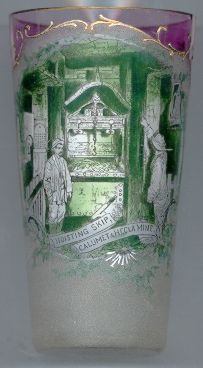

|
| UNITED STATES OF AMERICA | |
| MICHIGAN | |
| Houghton County |
| ALT: Hecla, Laurium, Red Jacket |
 Calumet began to develop as a village of officers and employees of the copper mines of the Calumet & Hecla Mining Company. It became a civil
township in 1866. Gradually it composed of the surrounding communities of Laurium, Hecla and South Hecla.
Laurium was originally incorporated as Calumet in 1889 and was reincorporated as Laurium in 1895 (Laureion in Attica was
a district in ancient Greece and was famed for its rich silver mining sites).
Between 1867 and 1884 the Calumet & Hecla Mining Company, based in Calumet, produced half the nation's copper.
The Red Jacket shaft, at more than 8,000 feet (about 2,440 m) in depth, was the deepest in the world.
In 1929 Laurium, Hecla and South Hecla united with the incorporated village of Red Jacket under the name of Calumet
(a calumet was the clay stone bowl of the Indian peace pipe).
Calumet began to develop as a village of officers and employees of the copper mines of the Calumet & Hecla Mining Company. It became a civil
township in 1866. Gradually it composed of the surrounding communities of Laurium, Hecla and South Hecla.
Laurium was originally incorporated as Calumet in 1889 and was reincorporated as Laurium in 1895 (Laureion in Attica was
a district in ancient Greece and was famed for its rich silver mining sites).
Between 1867 and 1884 the Calumet & Hecla Mining Company, based in Calumet, produced half the nation's copper.
The Red Jacket shaft, at more than 8,000 feet (about 2,440 m) in depth, was the deepest in the world.
In 1929 Laurium, Hecla and South Hecla united with the incorporated village of Red Jacket under the name of Calumet
(a calumet was the clay stone bowl of the Indian peace pipe).
Calumet is also home to Coppertown USA museum and visitor center which tells the story of the mines, communities and people of the Keweenaw Peninsula. Reports of enormous copper deposits here ignited America's fast mining boom in 1843, a half dozen years before California's gold rush. By 1849, Michigan’s Copper Country provided 85% of the entire United States copper production. These were the richest deposits ever discovered. The mines played an important role in America's Industrial Revolution and performed a crucial mission by supplying copper for military equipment during the Civil War. Between 1845 and 1967, the copper mines on the peninsula produced 11 million pounds of copper. The native copper range forms a narrow spine along the peninsula. The most prominent feature is a 4 to 12 mile wide ridge that forms the copper range and represents a spectacular example of the 1.1 billion year old mid-continent rift. Its glacial topography is only slightly affected by erosion. Hundreds of ancient mining sites, mined in prehistoric times, also lie along the peninsula. The Keweenaw National Historical Park was established in 1992 to commemorate the rich history of copper mining on the Keweenaw Peninsula.
The picture on glass no. 1731 shows a hoisting skip used to lift the copper ore to the surface.
[Part of the text adapted from http://www.scripophily.net/calhecin.html].
![[scale]](lineal.jpg)